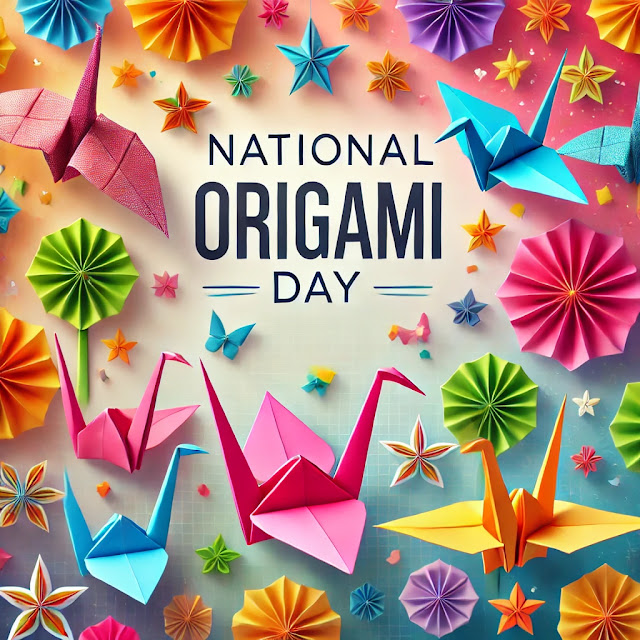National Origami Day: Celebrating the Art and Joy of Paper Folding
National Origami Day, celebrated annually on November 11, brings attention to the beautiful and intricate art of origami. This traditional Japanese craft, dating back centuries, has transcended cultural boundaries, inspiring creativity, patience, and precision in people of all ages. From simple paper cranes to complex 3D structures, origami transforms a humble sheet of paper into endless possibilities.
The Origins of Origami
The word "origami" comes from two Japanese words: "ori" meaning "folding" and "kami" meaning "paper." Origami as we know it began in Japan around the 17th century, although paper folding has roots in China and Europe as well. In Japan, origami became a part of social rituals and ceremonies, with cranes and other designs carrying deep symbolic meanings. The iconic origami crane, for example, is a symbol of peace and hope.
Origami spread globally in the 20th century, gaining popularity due to its educational, artistic, and therapeutic qualities. Today, origami is recognized as a valuable skill-building activity that promotes mindfulness, concentration, and an appreciation for detail.
The Benefits of Practicing Origami
Origami is more than a craft; it offers a variety of mental and physical benefits:
- Enhances Focus and Patience: Folding paper requires precision and attention, helping individuals develop focus and patience. The step-by-step process encourages a calm, focused mindset.
- Improves Cognitive Skills: Origami involves spatial reasoning, geometry, and fine motor skills, making it a helpful tool for children and adults alike to improve brain function.
- Promotes Creativity and Innovation: Each fold opens up new possibilities, allowing artists and hobbyists to experiment and develop unique designs. Origami encourages thinking outside the box and solving complex visual problems.
- Provides Therapeutic Benefits: Origami’s calming effect can reduce stress, making it a valuable practice in art therapy. The repetitive, precise movements help soothe the mind and promote mindfulness.
- Builds a Sense of Accomplishment: Completing an origami project, no matter how simple or complex, brings a sense of satisfaction and accomplishment.
How to Celebrate National Origami Day
- Learn New Designs: Challenge yourself by learning new origami patterns. Whether you’re a beginner or a seasoned origami enthusiast, there’s always a new design to explore.
- Host an Origami Workshop: Gather friends, family, or coworkers to celebrate by teaching them a few simple folds. Origami is a great group activity that fosters teamwork and creativity.
- Use Origami for Decoration: Make origami decorations for your home, workplace, or school. Paper cranes, butterflies, and flowers make wonderful, colorful decorations and add a touch of creativity to any space.
- Share Your Work on Social Media: Show off your creations with the hashtag #NationalOrigamiDay and connect with other enthusiasts. You may discover new patterns and ideas from the origami community.
- Support Origami Artists: Many artists have made a profession out of origami, creating intricate, beautiful designs. Support their work by following them online or purchasing their creations.
Fun Facts About Origami
- The 1,000 Paper Cranes Legend: In Japan, it is said that folding 1,000 origami cranes, or senbazuru, grants the person a wish. This legend was popularized globally by the story of Sadako Sasaki, a young Japanese girl affected by the Hiroshima bombing, who folded cranes as a symbol of peace.
- No Scissors or Glue Needed: Traditional origami strictly uses only a single piece of paper without cutting, gluing, or marking, emphasizing the purity of the art.
- Mathematical Impact: Origami has influenced various fields of mathematics, inspiring studies in geometry, engineering, and design. Techniques used in origami are applied in modern engineering, such as folding designs in solar panels or airbags.
- Largest Origami Sculpture: The Guinness World Record for the largest origami sculpture is held by a 256-foot-tall paper crane created in Japan.
- Origami in Space: NASA has used origami principles to design compact, foldable space structures, such as satellite panels and telescopes.
Conclusion
National Origami Day celebrates the delicate beauty and complexity of folding paper into art. Origami's universal appeal and versatility have made it an inspiring activity for centuries, crossing cultural and artistic boundaries. Whether for relaxation, creativity, or education, origami continues to play a valuable role in our lives. This National Origami Day, pick up a sheet of paper, fold it into something beautiful, and appreciate the magic of transforming a simple square into something extraordinary.




